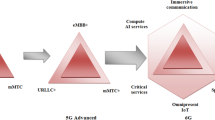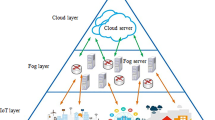Abstract
The deployment of a broadband public safety (PS) mobile network can be undertaken in different ways. One method involves combining commercial networks with private ones to reduce their deployment cost and time to market. In shared commercial networks, priorities should be defined to differentiate traffic not only between consumers and PS users but also between different PS organizations and type of services. Prioritization must also ensure that emergency calls are always served under normal conditions and during disasters. The recent advent of the fifth generation (5G) wireless standard introduces new technologies, such as network slicing (NS), which allows the provision of logical PS networks in a shared 5G system wherein each slice can be dedicated to an organization or to a type of service. However, 5G management and orchestration become a challenging task with NS, e.g., in handling resource allocation between slices with diverse requirements. Therefore, efficient solutions for slice resource allocation are required to facilitate this task. In this paper, we present a review of adaptive and dynamic resource allocation leveraging on heuristic and reinforcement learning-based algorithms that have been proposed in the recent literatures. The challenge in implementing these algorithms is to find the most suitable one for our problem, i.e., an algorithm that is highly scalable, able to solve problems immediately, and exhibits the best convergence properties in terms of speed and ability to find the global optimum.








Similar content being viewed by others
References
Baldini, G., Karanasios, S., Allen, D., & Vergari, F. (2014). Survey of wireless communication technologies for public safety. IEEE Communications Surveys & Tutorials, 16(2), 619–641.
Kumbhar, A., Koohifar, F., Güvenç, İ., & Mueller, B. (2017). A survey on legacy and emerging technologies for public safety communications. IEEE Communications Surveys & Tutorials, 19(1), 97–124.
Avramova, A. P., Ruepp, S., & Dittmann, L. (2015). Towards future broadband public safety systems: Current issues and future directions. In International conference on information and communication technology convergence (ICTC) (pp. 74–79).
Yu, W., Xu, H., Nguyen, J., Blasch, E., Hematian, A., & Gao, W. (2018). Survey of public safety communications: User-side and network-side solutions and future directions. IEEE Access, 6, 70397–70425.
Ergul, O., Shah, G. A., Canberk, B., & Akan, O. B. (2016). Adaptive and cognitive communication architecture for next-generation PPDR systems. IEEE Communications Magazine, 54(4), 92–100.
3GPP TS 23.203 v. 8.8.0, “Policy and Charging Control Architecture”, Dec. 2009.
Alasti, M., Neekzad, B., Hui, J., & Vannithamby, R. (2010). Quality of service in WiMAX and LTE networks. IEEE Communications Magazine, 48(5), 104–111.
Höyhtyä, M., Lähetkangas, K., Suomalainen, J., Hoppari, M., Kujanpää, K., Ngo, K. T., et al. (2018). Critical communications over mobile operators’ networks: 5G use cases enabled by licensed spectrum sharing, network slicing and QoS control. IEEE Access., 6, 1.
3GPP TR 28.801 V1.2.0 (2017-05), “Study on management and orchestration of network slicing for next generation network (Release 15)”, Jan. 2018.
Alliance, N. (2016). Description of network slicing concept. NGMN 5G P1 Requirements & Architecture, Work Stream End-to-End Architecture, Version 1.0.
5GPPP, “View on 5G Architecture (Version 2.0)”, 5G PPP Architecture Working Group, Athens, Jul. 2017.
Zhou, X., Li, R., Chen, T., & Zhang, H. (2016). Network slicing as a service: Enabling enterprises’ own software-defined cellular networks. IEEE Communications Magazine, 54(7), 146–153.
Nakao, A., Du, P., Kiriha, Y., Granelli, F., Gebremariam, A. A., Taleb, T., et al. (2017). End-to-end network slicing for 5G mobile networks. Journal of Information Processing, 25, 153–163.
Ordonez-Lucena, J., Ameigeiras, P., Lopez, D., Ramos-Munoz, J. J., Lorca, J., & Folgueira, J. (2017). Network slicing for 5G with SDN/NFV: Concepts, architectures, and challenges. IEEE Communications Magazine, 55(5), 80–87.
Rost, P., Mannweiler, C., Michalopoulos, D. S., Sartori, C., Sciancalepore, V., Sastry, N., et al. (2017). Network slicing to enable scalability and flexibility in 5G mobile networks. IEEE Communications Magazine, 55(5), 72–79.
Han, B., Feng, D., & Schotten, H. D. (2018). A Markov model of slice admission control. IEEE Networking Letters, 1, 2–5.
ETSI GS NFV-INF 001 V1.1.1, “Network Functions Virtualisation (NFV); Infrastructure Overview”, Jan. 2015.
ONF TR-521, “SDN Architecture Overview”, Issue 1.1, 2016.
Sutton, R. S., & Barto, A. G. (2017). Reinforcement learning: An Introduction. A Bradford book. Cambridge: The MIT Press.
Jiang, M., Condoluci, M., & Mahmoodi, T. (2016). Network slicing management & prioritization in 5G mobile systems. In 22nd European wireless conference VDE 2016 (pp. 1–6).
Bega, D., Gramaglia, M., Banchs, A., Sciancalepore, V., Samdanis, K., & Costa-Perez, X. (2017). Optimising 5G infrastructure markets: The business of network slicing. In IEEE conference on computer communications INFOCOM 2017 (pp. 1–9.).
Natalino, C., Raza, M. R., Rostami, A., Öhlen, P., Wosinska, L., & Monti, P. (2018). Machine learning aided orchestration in multi-tenant networks. In IEEE photonics society summer topical meeting series (SUM) (pp. 125–126).
Han, B., Lianghai, J., & Schotten, H. D. (2018). Slice as an evolutionary service: Genetic optimization for inter-slice resource management in 5G networks. IEEE Access, 6, 33137–33147.
Li, R., Zhao, Z., Sun, Q., Chi-Lin, I., Yang, C., Chen, X., et al. (2018). Deep reinforcement learning for resource management in network slicing. IEEE Access, 6, 1.
Tang, L., Tan, Q., Shi, Y., Wang, C., & Chen, Q. (2018). Adaptive Virtual resource allocation in 5G network slicing using constrained Markov decision process. IEEE Access, 6, 61184–61195.
Watkins, C., & Dayan, P. (1992). Q-learning. Machine Learning, 8, 279–292.
Mao, H., Alizadeh, M., Menache, I., & Kandula, S. (2016). Resource management with deep reinforcement learning. In Proceedings of the 15th workshop on ACM HotNets.
Moriarty, D. E., Schultz, A. C., & Grefenstette, J. J. (1999). Evolutionary algorithms for reinforcement learning. Journal of Artificial Intelligence Research, 11, 241–276.
Mnih, V., Kavukcuoglu, K., Silver, D., Rusu, A. A., Veness, J., Bellemare, M. G., et al. (2015). Human-level control through deep reinforcement learning. Nature, 518(7540), 529–533.
Powell, W. B. (2008). What you should know about approximate dynamic programming. Hoboken: Wiley.
Author information
Authors and Affiliations
Corresponding author
Additional information
Publisher's Note
Springer Nature remains neutral with regard to jurisdictional claims in published maps and institutional affiliations.
Rights and permissions
About this article
Cite this article
Othman, A., Nayan, N.A. Efficient admission control and resource allocation mechanisms for public safety communications over 5G network slice. Telecommun Syst 72, 595–607 (2019). https://doi.org/10.1007/s11235-019-00600-9
Published:
Issue Date:
DOI: https://doi.org/10.1007/s11235-019-00600-9




